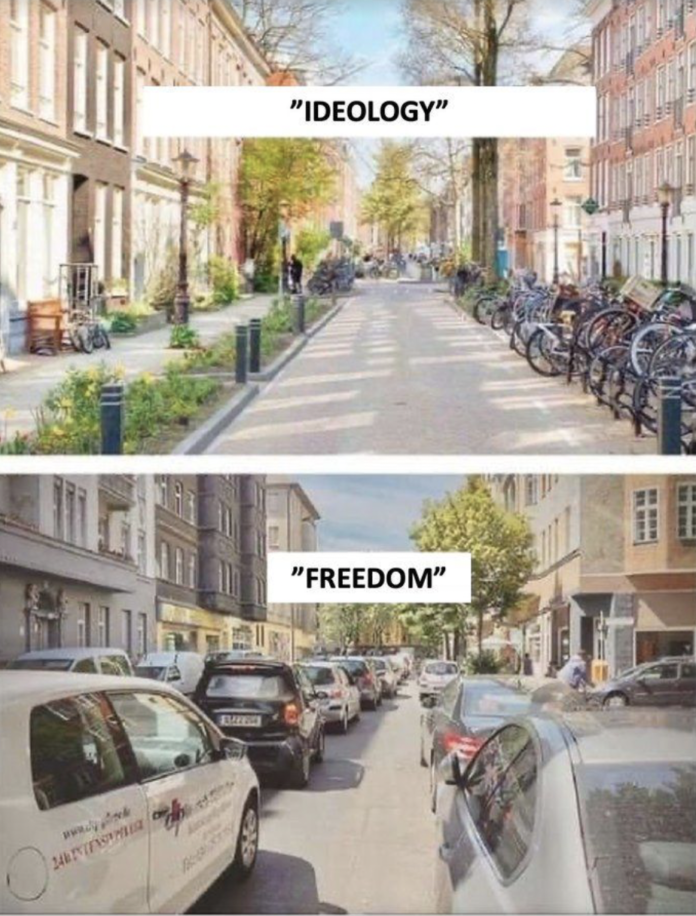Our city centre shopping streets are surrounded by a wasteland of low level commercial activity with the people forced out to live in the suburbs. This creates the need for expensive infrastructure to support those outer areas, (parks, schools, water, and waste), and roads with congestion, and public transport needs. Many with a costly impact on rates.
And you guessed it – conservative councils and politicians of the past are primarily responsible.
This push, outward to the suburbs, is in part because of zoning laws which were initially thought of as separating our industries with noise and chemical risks away from where people lived. (I’m ignoring all the suburbs history for my purposes) But with the zones we don’t have much industry anymore.
The zones created cost reductions for businesses as they reduced the purposes for which land could be used for, and so it reduced the number of bidders. Commercial businesses could therefore get central city land cheaper. Same if they wanted residential land.
In Wellington, the zoning problems were made worse by conservative councils changing the rating system from being calculated on unimproved land value; which meant the more central the land the more rates you paid. They shifted the rates calculations so that ‘users’, the demand side of the economy paid much more. This was seen to help business, the supply side of the economy, reduce costs.
So the neo-liberal philosophy of removing costs from businesses so they would have investment capital to drive growth in the economy, has done the exact opposite. The lack of cost for land resources has created lazy businesses who then land-banked central city land as a low risk investment (invested in non-productive capital assets as it was low cost to do so). And they might run a minor business like car parking on that land and any loses would be tax deductible. Win/win for business.
The red tape zoning laws, were actually business favourable and really developed by councils who were very close to following business interests. Just one example of businesses being one of the major creators of red tape. A libertarian free for all is not the answer; the exact opposite is needed. We need community planning.
We desperately need affordable housing; and access to under-utilised commercial land in the central city is critical to getting this. Perhaps Kainga Ora could build over the airspace of business; i.e. the business gets a new street level office or shop in a new building but lots of residential accomodation is above? The car yards on Wellington’s Cambridge and Kent Terrace are an underutilisation of large lumps of land that should be made available for affordable housing.
Pre-1930’s heritage buildings are a limited resource and must be protected as they are critical to social identity. Continuity with the past promotes a sense of what makes us different and special. It also has a huge tourism value: one of our biggest industries. It’s also a great water soak in storms.
We need to rethink the zoning and rates rules, to get people back into our central cities to reduce our greenhouse gas emissions and our car obsession, to reduce our sprawling underground infrastructure costs with all its costly maintenance, to reduce our rates.
Increase city rates for businesses, to provide an incentive to business to develop their central city land. If businesses/developers are going to build shops or malls perhaps they should be required to have housing above them? Well designed mid rises? This would be a better way to get people into your business than having street level car parks.
Zoning should be completely overhauled. Perhaps the zones should be (?) risk of large scale dangerous chemical spills; or loud noise ( this one possibly should be about requiring noise to be contained within the property?). Most zones should require new developments to contain residential accomodation? To help deal with the affordable housing crisis.
Zoning laws and rates are some of the key ways to force a change to densification of our cities; as they have been central to the waste we currently see. New rules need to allow people to reclaim the central cities; being able to live central in the lively bustle of shops and entertainments.





Our cities are a sad joke, go to Ozzy to see real 1st world cities. All our money has gone feathering scumlords nests. Jacinda said she would not introduce a CGT, OVER TO YOU CHIPPY!!!!!!
Ozzie City centres are just less hopeless..
Windage you really are a wind bag. Ok let’s have your CGT…boom…bingo…suddenly our inner cities are so much more fun to live in. Yeah right. What a stupid argument!
Conflating two separate issues so that the assumption of a CGT bring the panecea for inner city decline// I would argue that Australia isn’t the model we should be looking at. Every European city I’ve been to has people living in their thousands above the shops right down onto main street..
Normal, everyday people, just like the ones you work with, or nicer… And it doesn’t cost them an arm and a leg to live there… The city center has a measurable pulse in all those cities/towns…
I think in the local situation this is largely due to the general weak state of the economy, as generated by far-right economic policies.
The downtown areas used to be fairly vibrant, busy places. But once real production and diversification went into reverse, so did investment (and wages) — so you began to see a sort of cultural wasteland developing in the cities.
If the downtown areas had continued to develop properly, large multi-storey shopping malls and department stores would dominate the High Street. There would be a large number of cultural events in nearby public squares and stadiums, drawing big crowds.
Rather than all the public transit being torn out, there would have been attempts to increase the tramways and trolleylines and divert traffic. People from inner suburbs wouldn’t be forced to travel outwards to go shopping, but could go inwards.
The downtown area itself could be almost entirely high-rise commercial, so long as there is sufficient transportation and well-developed inner suburbs.
The issue really is that NZ does not keep. They did not keep their trams. They concreted them over or ripped them out. ditto with trains. Ditto with nice old houses. So now you have towns devoid of character, public transport and old shops. But rejoice, you get the same chicken cage towers that just collapsed by the thousands in the turkey earthquake three weeks ago, still have no public transport, and the trains run sometimes. In yer car citizen if you want to go downtown, but we charge you a congestion charge for that trip. Sucks to be a poor one, who lives no where near a town centre – large or small. Which is most people.
The redevelopment of Christchurch is a perfect example of this eternal stinginess and blinkered thinking.
The city had a perfect opportunity to reinstall all the tramways, trolleybuses and suburban railways (all three had been entirely removed for no good reason).
It was also the perfect opportunity to build a lot of very tall buildings (the lack of which had rendered the downtown area useless for shopping).
None of these things happened. Even worse, the character of the city was entirely destroyed — none of the trademark Victorian architecture was rebuilt. Atrociously cheap and ugly buildings were slapped together instead, which were already too small the moment they opened.
our situation is due to the weak state of the state and polititians abdicating decision making to to banks and think tanks
and brownlow was in charge of chch rebuild he fucked that one up by being a corprate lacky
a few yrs ago wellie got rid of the last of it’s electric trolley buses…why? search me
“Pre-1930’s heritage buildings are a limited resource and must be protected as they are critical to social identity.”
No.
Yes. They should be protected. That does not imply you can’t sensibly build around them. But we don’t do ‘sensibly’.
Character? What character?
‘Protecting heritage’ and preserving ‘character’ is a privilege of those smug people already comfortably housed within the restricted area.
hi Ada, your argument doesn’t apply to tourists. And it also means you can’t enjoy something and want to preserve it. I unfortunately can’t afford to live in heritage house.
I wonder what ‘social identity’ is, any takers?
Don’t know, have a look at a lot of the very old old towns in Europe and understand that they all have running hot/cold water, electricity and internet.
Dors not matter what it is as long as we recognise and respect equality of social transidentity, cisidentity and fluididentity.
Hi gagarin, good question; but it does exist. Sort of like going to Australia compared to NZ. There is something different even though people are people. Same travelling elsewhere. Our built, and physical environment does help shape us, our attitudes. But there is clearly a full range of diversity within that difference. We are still human.
so cutting the pseudo intellectualism what we’re talking about is atmosphere..and as far as it goes our archetecture largely resembles the midwest of the US same period same materials…and a few faux raj mansions
Why are our cities empty in the middle?
Easy answer: town planners’ fantasies of designing the perfect city, and the ordinary Kiwi citizens’ contempt of apartment dwellers. Town planner laid out zones like Napolean planning what parts of Europe would be subjugated, and with as little concern for the people involved.
As for apartments, those were for the slums of Europe..
When your inner-city heritage suburb was built, a single family home built on a separate section was what a ‘successful’ life looked like.
It used to be residential project and commercial. Now it’s just residential and project. To monopolies playing big wallet little wallet.
Stephen
Your last paragraph…seriously??? Densification? Why would anyone want to live in the city in NZ? Everyone wants to be out of the bloody city as fast as the can and get some fresh air. Why do you, and Central Control Labour, want to force people to live where you want them to live…in those depressing concrete blocks. NZ has so much land with so few people to use it, why do want us be like Chicago or Detroit??? Is it the Socialsit dream to have inner city ghettos with dreary grey apartment blocks? It’s all about central control isn’t it, as I cannot think of any other reason for forcing that stupid unaffordable ICRL on us in AKL. Because once that is done, the train stations with surrounding grey and dreaery apartment blocks, Moscow style, will follow. The movie Nil By Mouth springs to mind..
Not one of the two pics provided show an actual NZtown. We build shitty and unsustainable highrises to cage humans and don’t invest in public transport. We don’t do city planning and we are 50 years behind Europe where these pictures are likely from.
Wellington is atypical because it is ringed by mountains and sea, preventing the normal growth of the CBD and easy transport routes. Rather than invest in Transmission Gully we would have been far better off if we’d dispersed the various government functions around the country. Because with modern communications there is no need to be in the same office to function as a team. Far bigger, better, international organizations do it with ease today.
Besides Wellington isn’t a real city – it’s a port village with a parliament. In real cities a critical mass is reached where they devolve into conurbations with people living, working and shopping in their suburb. The hub & spoke concept falls apart because of the difficulty and cost of moving millions of people around needlessly.
In the case of Auckland, the council has turned our once vibrant CBD into a dead zone of orange road cones, empty cycle lanes and a violent underclass. I live a nominal 10 minutes from the CBD but haven’t been there for over a year.
Simple, They are empty as they are old, tired, boring, dirty, shitholes that have a nasty feeling to them.
I’m currently in Nicaragua and while there are guns everywhere I still feel a LOT safer than I do at 9pm in Queen Street.
Same-same re @ Peter Barry comment.
Neoliberalism’s depleted our humanism by replacing our broader humanity with a more personalised form of soulless greed. I was more than a little trepidatious on my first visit to Phenom Penh, Cambodia years ago. The cab driver was laughing at my reaction to his waving his semi auto pistol around as he drove through hot dark streets past the night people, people who came out to shop and trade only to be replaced by the day people doing the same sorts of things. A kind of retail night shift arrangement. Once I got out of the cab with no bullet holes to report and past the busy darkness, pot holes, smells, stinks, roaming dogs and dodgy young women with deep voices and large Adam’s apples selling blow jobs, I leaped to my hotel door, a fabulous old bullet holed 1920’s deco building, past smack dealers and parrot wrestlers where I, true to my bad-luck calling, hit the wrong button on the greasy elevator pad and instead of floor 6, I went to floor 3. I stepped out all a fluster and sweating like a guilty man onto the brothel floor. There, I saw a larger than normal room with a glass wall and behind that there were young women, the grand children of Pol Pot, wearing short skirts sitting along red carpeted planks with numbers pinned to them. I stopped and gaped like a Mormon in a dildo shop and as I turned to slink out to make good my escape I saw the clientele waiting, smoking, glaring at this white, jumpy, Farang. The first thing I noticed were the machine guns, as one would, then the uniforms. Then the icy-staring Cambodian soldiers on furlough! You know when you see in horror movies where the victim’s in an elevator stabbing at the buttons in a desperate panic? Cambodian soldiers have a certain look about them that’s not from this earth.
But at least Phenom Penh was alive. Not like a scene out of a Kiwi version of The Last of Us. Our dismal cities are dismal because the greed for ever more money has no imagination no limitations. We’ve become victims of ‘greedflation’.
ECB looking out for price gouging as fears grow over ‘greedflation’
https://www.theguardian.com/business/2023/mar/02/ecb-looking-out-for-price-gouging-greedflation-price-rises-eurozone-inflation-profit-margins
‘Greedflation’ becomes a thing when workers have no union power and unions were the first to be chopped at the dawn of neoliberalism when unbridled greed took hold, then cities die and the countryside becomes a no persons land. Sound familiar? But hey! Nine multi billionaires and four now foreign owned banks stealing billions off us in net profits annually and this year they stole more than ever so it’s not all bad for everyone.
Town centers were not empty 20 years ago
So why are they empty now? Because the political left has made it so hard to get there. They insist on closing down vehicle parking and forcing people to change transport modes. The people recognise that changing transport modes costs them time and reliability. How have people reacted? They have not changed transport mode but have changed where they congregate.
The suburban malls are absolutely humming. They can’t believe their luck that our city hierarchy have restricted movement in the central city to such a large extent.
As is always the case with the political left, they make decisions without fully understanding how people will react. Then when people react in ways they don’t like, the political left finds a way to blame another party, in this instance former “conservative” councils. The only blame in this instance can be found via a conventional mirror.
could have something to do with the capitalist mega malls and the demise of small shops real?
In Wellington ever changing earthquake strengthening rules aren’t helping, plus fantasists who want to turn the town into another Amsterdam regardless of the realities and regardless of what most of the citizens actually want.
you can harden things against earthquakes but nothing is earthquake proof ask the japanese.
Daniel
Right on the nail.
Von Thunens concentric rings theory of urban development…learnt that 45 years ago. It seemed cogent at the time but took no regard to the impact of automobiles enabling strip malls and vast suburban development, nor of the end of industry as it got offshored. I really think town planners are the people looking for the horse after it has bolted.
Keep informing Nick J – von Thunen is new to most of us. A wormhole into the morass of ideology that we can edge into to add to our nous. And as for the horse, that’s 20th century thinking having let it bolt. Now we are so unstable, heh, I think we should look to co-owning a horse and finding ways to set up horse-only areas of the city, cycle and horse only roads, plus rickshaws. We have to start thinking laterally and even inverted, reversed; going backwards to go forwards is too revolutionary for the narrow specialists of today.
The city is full of Ideology of the administrators who are following each others ideas that have been born in some university. They are made to look good and hoping that some famous travel writer and painter will paint them so that tourists will come and spend money and sit at outdoor cafes. Ordinary people don’t have time to do this. Retired people are too busy planning trips elsewhere to patronise their own roundtable arena.
When I was working in the local fish factory and had half an hour for lunch I think, short time anyway, I needed to get into town, parked on a yellow line and was prevented from doing some small financial transaction being served by classist people who didn’t like my plain clothes, or my fish smell, or my work-induced urgency. And it isn’t necesssarily easier or better doing financial or other things by machine.
As a very ordinary citizen I don’t occur in the thoughts of the green inspired admin lords. Bikes Rules Okay but that is a cult now, where they blast out tracks through native bush for the bloody mountain biking and probably add to slips in our downpours becoming too frequent. Or they point their pointy-bottomed lycra backsides at drivers while they ride side by side on roads built and paid for by the motorist.
Good rant eh The most honest thoughtful piece written today?
Answer is simple- because most human skulls are empty in the middle
What could possibly go wrong having KO tenants living above your business…..
City life isn’t for everyone. I lived in an apartment in WLG in my late 20’s, it was great. In my 40s now and writing this from my deck on a 1100m2 bush clad property just 25 mins from the city with my closest neighbor 30 metres away.
Great Raf – I hope that the climate events don’t bring the trees down on you. Have you carefully planted the fire resistant green plants around your home that would help to preserve it if fire broke out? It coupled with winds is going to be one of our great problems – it will be sort of a witch-burning with us all being punished for our sins of lack of embracing the environment and lack of caring community for each other. I don’t believe this sort of thing mind you, not directly, but it’s a good analogy.
I was not aware of fire resistant trees but will put research about them on the to do list. There was a bush fire nearby last year actually, we were never in serious danger but it gave us a little fright seeing smoke over the next ridge and helicopters fighting the fire. Our house is 2 foot thick concrete, hopefully that counts for something.
raf, stronger vetting and ko having balls around evictions would solve many issues, typical rightwing pick the worst scenario and claim it’s the norm
Christchurch is definitely hollow on the middle. Initially due to the earthquakes, but long term to the right royal fuck up by National, Creepy’s bloated ego, and the staggering incompetence by his favorite arse kisser, Brownlee.
Bruce, the centre of Chch was getting hollowed out in the 70s. The local company head offices were bought up by Auckland or Aussie interests, so commerce moved away. Malls began to be built so shopping moved as well. The earthquake just made it obvious.
there are some good ‘urbanist’ channels on you tube for those who want to actually learn about the subject in hand
there’s one a yank guy who lives in holland he is particularly good he’s a cyclist but once you’ve factored that in he has interesting things to say